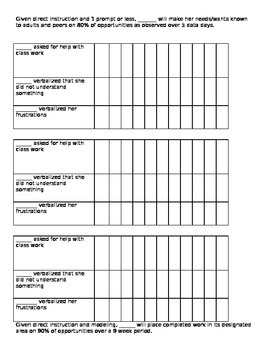Self Regulation IEP Goal: What It Is and How It Helps Students Succeed Self-regulation is a crucial skill that helps students navigate their emotions, behavior, and attention, leading to better academic performance and overall well-being. When it comes to Individualized Education Plans (IEPs) for students with special needs, self-regulation goals play a significant role in their educational journey. In this post, we will explore what a self-regulation IEP goal entails, why it is important, and how it can be achieved. Subheading 1: Understanding Self-Regulation in the Context of IEP Goals Self-regulation involves a student's ability to manage their thoughts, emotions, and behaviors to achieve their goals effectively. It is an essential skill for all learners, and particularly critical for students with special needs. When developing IEP goals related to self-regulation, the focus is on helping students develop strategies and habits that contribute to their overall success in the classroom and beyond. To illustrate the importance of self-regulation in the context of an IEP goal, let's consider an example scenario. Imagine a student named Alex who has autism spectrum disorder. Alex often experiences difficulty managing transitions and displays challenging behaviors when faced with unexpected changes in routine. A self-regulation goal for Alex could be to develop strategies to cope with transitions more effectively, leading to a calmer and more focused learning environment. Subheading 2: Creating a Self-Regulation IEP Goal Developing a self-regulation IEP goal requires collaboration between teachers, parents, and other relevant professionals. The goal should be specific, measurable, attainable, relevant, and time-bound (SMART). Here is an example of a self-regulation IEP goal for a student: Goal: By the end of the academic year, [Student's Name] will independently use at least two self-regulation strategies to manage transitions, as observed in 80% of occasions, as measured by teacher reports and student self-reflection. This goal clearly outlines the desired outcome, provides a time frame for achieving it, and specifies how progress will be measured. It also emphasizes the importance of promoting student independence and self-reflection. Subheading 3: Strategies for Achieving Self-Regulation IEP Goals There are several evidence-based strategies and interventions that can help students achieve their self-regulation IEP goals. Let's explore some of these strategies: 1. Visual Supports: Visual supports, such as visual schedules, timers, and cue cards, can assist students in understanding and preparing for transitions. These visual aids provide predictability and structure, reducing anxiety and improving self-regulation. 2. Social-Emotional Learning: Incorporating social-emotional learning (SEL) programs into the curriculum can be highly effective in helping students develop self-regulation skills. These programs teach students to identify and manage their emotions, make responsible decisions, and develop healthy relationships. 3. Mindfulness Practices: Mindfulness exercises, such as deep breathing, meditation, and body scans, can support students in developing self-awareness and emotional regulation. These practices can be integrated into the daily routine to promote a calm and focused learning environment. FAQ Section: Q1: Is self-regulation only important for students with special needs? A1: No, self-regulation is a crucial skill for all students. It helps individuals manage stress, set goals, and make responsible decisions, contributing to their overall well-being and success. Q2: How can parents support self-regulation at home? A2: Parents can support self-regulation by creating consistent routines, providing visual supports, and modeling self-regulatory strategies. They can also encourage open communication and help their child develop problem-solving skills. Q3: Can self-regulation be taught and improved? A3: Yes, self-regulation skills can be taught and improved through explicit instruction, practice, and reinforcement. With guidance and support, students can develop effective strategies to regulate their thoughts, emotions, and behaviors. Conclusion: Self-regulation plays a crucial role in a student's ability to succeed academically, socially, and emotionally. Within the context of an IEP goal, self-regulation becomes even more significant for students with special needs. By developing specific and measurable goals, using evidence-based strategies, and fostering collaboration between teachers, parents, and professionals, students can make significant progress in developing their self-regulation skills. Ultimately, the successful achievement of self-regulation goals within an IEP sets students on a path towards a more independent and fulfilling educational experience.
7 Metas Medibles Del IEP Para Las Habilidades De Escritura | Expresión
 Image Source : neverthoughtaboutthat.com
Image Source : neverthoughtaboutthat.com Occupational Therapy Goals For Autism
 Image Source : matthewhowe.z13.web.core.windows.net
Image Source : matthewhowe.z13.web.core.windows.net Self Regulation IEP Goals (2022)
 Image Source : kotylo.com
Image Source : kotylo.com Imagine That You Show Up To An IEP (Individualized Education Plan
 Image Source : www.pinterest.com
Image Source : www.pinterest.com iep
Social Emotional IEP Goal Writing Guide | Social Emotional, Iep Goals, Iep
 Image Source : www.pinterest.com
Image Source : www.pinterest.com iep emotional social goal writing goals skills guide examples work school counseling behavior student education onestopcounselingshop visit good learning speech
188 Best Images About 5 Point Scales And Regulation Scales On Pinterest
 Image Source : www.pinterest.com
Image Source : www.pinterest.com scale point behavior emotional autism regulation spectrum asd scales kids social autistic test outbursts school disorder children self behavioral strategies
IEP Goal Data Sheets - Self-advocacy, Work Habits, Conversational Skills
 Image Source : www.teacherspayteachers.com
Image Source : www.teacherspayteachers.com data self iep advocacy sheets goal skills conversational habits work teacherspayteachers school goals
Student Self-Regulation Rubrics | Ubicaciondepersonas.cdmx.gob.mx
 Image Source : ubicaciondepersonas.cdmx.gob.mx
Image Source : ubicaciondepersonas.cdmx.gob.mx Scale point behavior emotional autism regulation spectrum asd scales kids social autistic test outbursts school disorder children self behavioral strategies. Imagine that you show up to an iep (individualized education plan. Self regulation iep goals (2022). Student self-regulation rubrics. Social emotional iep goal writing guide
 Image Source : neverthoughtaboutthat.com
Image Source : neverthoughtaboutthat.com  Image Source : matthewhowe.z13.web.core.windows.net
Image Source : matthewhowe.z13.web.core.windows.net  Image Source : kotylo.com
Image Source : kotylo.com  Image Source : www.pinterest.com
Image Source : www.pinterest.com  Image Source : www.pinterest.com
Image Source : www.pinterest.com  Image Source : www.pinterest.com
Image Source : www.pinterest.com  Image Source : www.teacherspayteachers.com
Image Source : www.teacherspayteachers.com  Image Source : ubicaciondepersonas.cdmx.gob.mx
Image Source : ubicaciondepersonas.cdmx.gob.mx